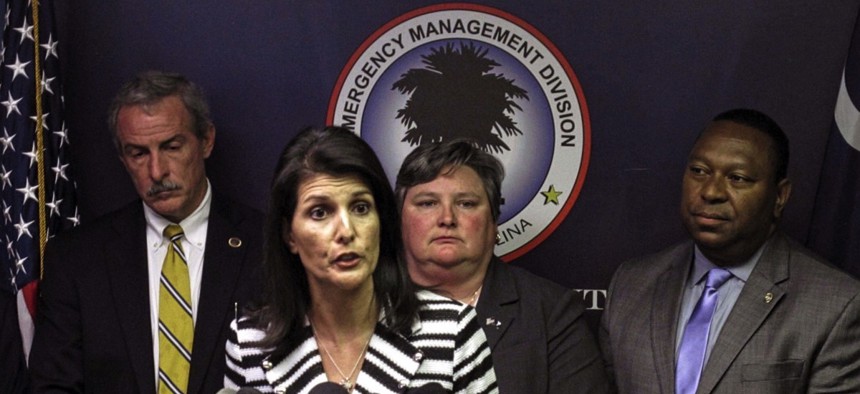Evacuation Orders, State of Emergency Declarations Made in Advance of Hurricane Matthew

Gov. Nikki Haley announces that she plans to call for the evacuation of about 1 million people from South Carolina's coast as Hurricane Matthew threatens on Tuesday, Oct. 4, 2016. Jeffrey Collins / AP Photo
State and local governments are preparing for a powerful tropical system to move up the Southeast coast: “We’re looking at Friday night into Saturday, or Friday afternoon into Saturday, being pretty brutal,” says South Carolina’s governor.
As Hurricane Matthew hit Haiti on Tuesday with devastating force, state and local officials in the southeastern U.S. were monitoring the powerful storm and taking steps to prepare for the winds, rain and flooding it could bring to their region later in the week.
Matthew made landfall near Les Anglais, Haiti around 7 a.m. Tuesday. The National Hurricane Center reported that the Category 4 Hurricane’s maximum sustained winds were roughly 145 mph. Current weather models show the storm nearing Florida on Thursday and then arriving along the coast of the Carolinas around Saturday.
Predictions from the National Hurricane Center show probabilities in the 50 to 80 percent range of tropical storm force winds in eastern parts of Florida, Georgia and the Carolinas. And North Carolina authorities warned Tuesday that the storm could bring winds in excess of 100 mph on Saturday morning to areas near the state’s border with South Carolina.

South Carolina Gov. Nikki Haley on Tuesday called for about one million people to evacuate from coastal communities in the state. Evacuation efforts are slated to begin Wednesday afternoon. The state’s aim is to get people 100 miles away from the coast.
Highway lanes will be reversed to handle heavy traffic and there are plans to deploy roughly 250 standard school buses and additional special needs buses to help transport Charleston residents out of the city.
South Carolina no longer differentiates between “voluntary” or “mandatory” evacuations. But Haley warned that people who stay behind on the coast could get marooned due to the storm.
“We’re looking at Friday night into Saturday, or Friday afternoon into Saturday, being pretty brutal,” she said.
Haley directed people to the South Carolina Emergency Management Division’s website, where it’s possible to access a tool that offers evacuation instructions for a given address.
But Tuesday afternoon surging visitor traffic caused the site to crash at least once, according to the agency.
It was only about one year ago when historic “1,000-year” flooding swamped parts of South Carolina.
In Florida, Mayor Carlos Gimenez of Miami-Dade County advised local residents Tuesday that, “today would be a good day to make your preparations.”
“Buy your food. Buy your water. Get your gas,” he added during a news conference.
Gimenez believes lessons from previous hurricanes have left Miami-Dade better positioned to recover from harsh weather. For instance, more grocery stores and gas stations are equipped with generators than in the past, he said, which should allow them to re-open faster.
Gov. Rick Scott of Florida and Gov. Pat McCrory of North Carolina both declared states of emergency Monday in an anticipation of the storm. Haley did the same Tuesday morning.
“Here we go again,” McCrory said Monday at a news conference. “We’re going to do everything we can to be over-prepared and hopefully underwhelmed.” The state of emergency McCrory declared covers 66 counties in central and eastern parts of North Carolina.
The governor said that, in the immediate term, the declaration would waive restrictions on the movement of agricultural vehicles, which would help farmers expedite the harvest of crops, including corn, peanuts, tobacco, soybeans, cotton and sweet potatoes.
Many crops in the state, he said, had been damaged or destroyed by prior heavy rain and flooding during the last 10 days.
With the ground already saturated, McCrory pointed out that trees would be more susceptible to blowing down in high winds, possibly knocking out power lines. At the same time, swollen rivers from recent rainfall will raise the risk that Matthew will cause further flooding.
“It will create issues for North Carolina even if it just hits us with a glancing blow,” state Emergency Management Director Mike Sprayberry said at the news conference where McCrory spoke.
He said North Carolina officials have had conference calls with nearby states and Federal Emergency Management Agency offices in Philadelphia and Atlanta. One reason for these calls, he noted, is to help “synchronize” any evacuations. FEMA has also sent an incident management assistance team to the state, Sprayberry said.
The state, he added, wants to have equipment and other resources for response efforts staged no later than Thursday night, before any high winds are expected to arrive.
“I’m hoping this is a false alarm,” McCrory said. “But we can’t gamble.”
PREVIOUSLY on Route Fifty: “South Carolina Takes Stock of South Carolina’s Historic Flooding”
Bill Lucia is a Reporter for Government Executive’s Route Fifty and is based in Washington, D.C.
NEXT STORY: Flint’s New Public Health Crisis: People Are Getting Sick Because They’re Afraid to Wash Their Hands






